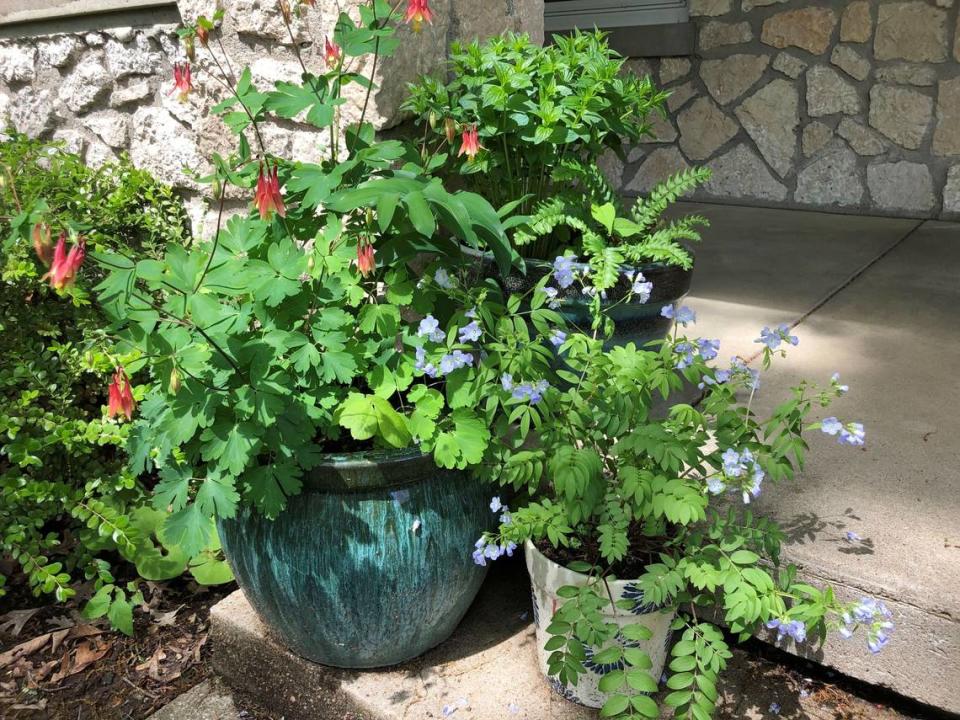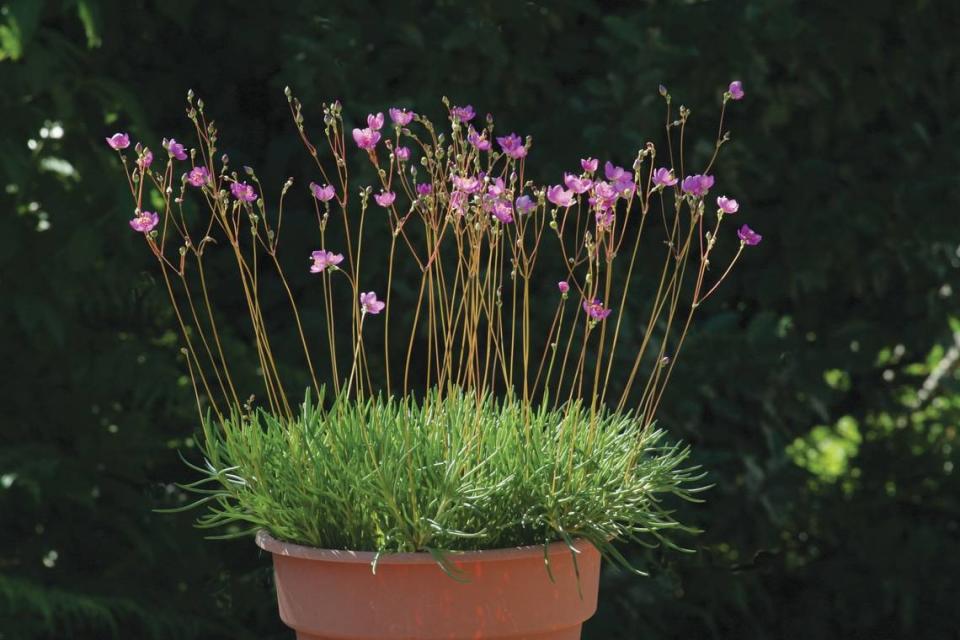No yard? No problem. Here’s how to grow native plants in containers in Kansas City
Pansies, daffodils and tulips may be synonymous with spring, but they aren’t naturally found in the prairie ecosystem that Kansas Citians call home. Instead, you may notice other types of grasses, flowers and shrubs popping up in vacant lots and rural areas around the metro.
Many of these are native plants: They thrive naturally in the Kansas City area because they have evolved to fit the weather, soil and temperatures of the Midwest.
Planting native plants is a great way to support your local ecosystem without tons of effort. But many Kansas Citians don’t have a yard of their own where they can start an outdoor garden. Luckily, many native plants can also thrive in containers on your porch, balcony, windowsill or even the roof of your building.
We reached out to native plant experts in the area to learn exactly how to set your native plant container garden up for success.
Where to find native plants in Kansas City
There are a wealth of nurseries in the Kansas City area specializing in native plants, including City Roots Nursery, Green Thumb Gardens, Happy Apple’s Farm, Parson’s Gardens, Missouri Wildflowers Nursery, Buffalo Seed Company and Sow Wild Natives.
One place from which you should NOT source your native plants is directly from nature. A wild native plant may make a tempting find, but the Missouri Botanical Garden notes that removing it could disrupt the surrounding ecosystem. Plus, the plant may not thrive in your container garden like it did in the ground.
If you’re gardening on a budget, consider sourcing your natives from a free seed library like Seed Savers KC or the Ruiz Branch of the Kansas City Public Library.
Grow Native! is a nonprofit run by the Missouri Prairie Foundation that works to educate the public about native plants. The group is holding native plant sales at the Anita B. Gorman Discovery Center in Kansas City from 10 a.m. until 2 p.m. on April 15, May 13 and Sept. 16.

Creating the perfect container
Almost anything can be used as a gardening container if you can drill a hole in the bottom, says Tracy Twombly, owner of the native plant nursery Sow Wild Natives in southeastern Kansas City. Containers can be almost any depth, although a foot or more of soil is ideal for larger plants. And unless you’re opting for a complex pond-style setup, drainage holes in the bottom of your containers are important to prevent your plants’ roots from drowning after a heavy rain.
Twombly said that most container materials are acceptable for gardening, but that they can slightly adjust the care your native plants will need.
“Anything that has a porous-type surface, the soil will dry out a little bit faster in those types of containers,” she told The Star. “It doesn’t mean you can’t use those containers, it just means that you might have to water a little bit more.”
Porous containers include those made of wood or unglazed ceramic. For more water-loving plants, a non-porous surface like shiny glazed ceramic, sturdy plastic or metal could be a better choice, writes local native plant expert Mervin Wallace for Grow Native!
The other component of a perfect container is soil. An ideal planting mix would actually contain very little soil — Twombly says she plants her native plants in a mixture of rice hulls, pine bark and compost. But for the average container gardener, loose potting soil from the garden store will work just fine.
If you’re looking to boost your soil game, Missouri Organic Recycling sells compost, mulch and other soil additives recycled from local yard waste and food scraps.
Twombly and Wallace both recommend avoiding soil mixtures that contain peat moss. This carbon-capturing substance forms in peat bogs over thousands of years, and its harvest is contributing to ecosystem destruction in North America.
Popular native plants and combinations
Twombly recommended choosing native plants for your container garden that can thrive in drier conditions, since the soil in containers dries out more quickly than the ground. Glade plants, or those typically found in grassy meadows, make great choices for containers for this reason.
“One of my absolute favorites is called Rock Pink — it’s a native succulent, and we just have one in a little pot on our front porch that I basically ignore all year long,” Twombly said. This hardy plant can tolerate extreme temperatures and even survive drought conditions.
Twombly also recommended columbine, a favorite of hummingbirds that can grow in a wide variety of conditions. Even when this flower isn’t blooming, she said, its striking foliage makes a beautiful addition to any container.

Here are a few other native plants Twombly recommended for container gardening:
Rose verbena: This hardy ground cover can grow to spill over the sides of your container and bears clusters of pink and purple flowers throughout the summer.
Whorled milkweed: This thin, compact milkweed is a favorite of endangered monarch butterflies and produces small white flowers.
Aromatic aster: This late-blooming wildflower can grow into a small bush bearing lots of light purple flowers. This plant is great for pollinators, including bees and butterflies.
Foxglove beardtongue: This tall, hardy plant bears bright white, tubular flowers beloved by bees and hummingbirds.
The local native plant nonprofit Deep Roots KC as well as Grow Wild! have a wealth of information about Missouri’s native species. Glow Wild’s top ten lists and native plant database are great places to start — and local native plant nurseries can give even more detailed advice.
“I would just say if you’d like to plant, try it in a container,” Twombly said. “A lot of these plants will surprise you and turn out okay in a container. You might even love it!”
Caring for your native plants
One big advantage of native plants is that they are already well-adapted to the temperatures and weather you’re likely to experience in Kansas City. The only difference, Twonbly said, is that they might need some extra water during the hot summer months.
“The plants will tell you when they need some water,” she said. Keep an eye out for drooping leaves and water accordingly. “I would choose plants that have similar sun and moisture requirements so that they can survive better (together),” she added.
For example, you can fill one container with sun-loving plants and another with plants that need to be watered more frequently. This will make your care routine simpler and allow similar plants to support one another like they would in the wild.
Check out the Missouri Botanical Garden’s “container recipes” for suggestions of which native plants do well together in shade or in sun.
Wallace notes, however, that you don’t need a strict watering schedule to help your native plants thrive. The rain your outdoor space gets will take care of some of the moisture they need — simply supplement with your own watering during particularly dry or hot periods.
When in doubt, Twonbly suggested sticking a finger into the top inch or two of soil in your containers. If you don’t feel any moisture, it’s time for another watering.
Do you have more questions about native plants in Kansas City? Ask the Service Journalism team at kcq@kcstar.com.

